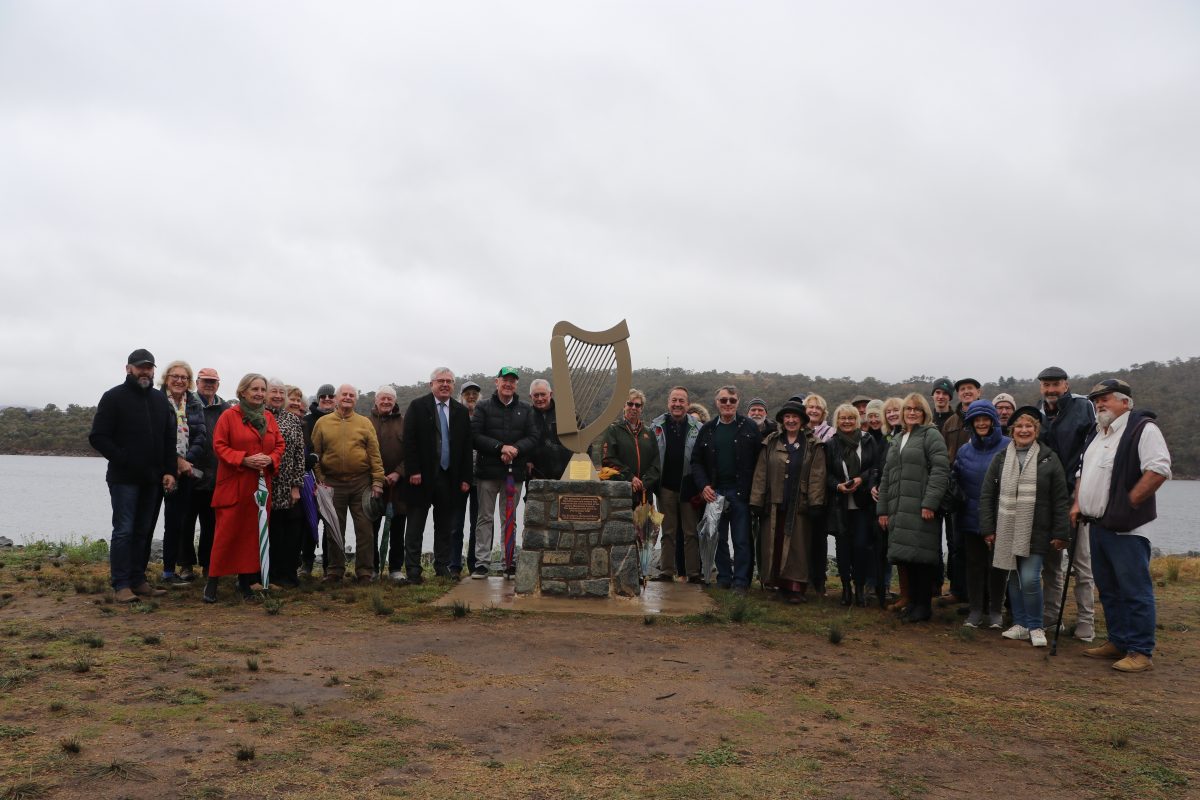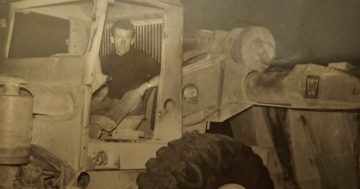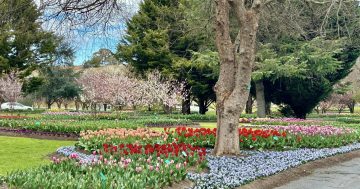
The Jindabyne community gathered in the rain on April 30 as the Irish Ambassador to Australia, Tim Mawe unveiled the restored Irish Harp Memorial on Lake Jindabyne’s foreshores. Photo: Supplied.
The inscription on the Jindabyne Irish Harp Memorial probably says it all: “This fine harp came to be through the imagination, desire and pride of four Irishmen in the year 2001.
“John McLoughlin, Harry Cummins, Arthur Costello and Michael Bates.
“May its presence bring a sense of peace and joy to all who pass this way.”
The Harp Memorial commemorates the Irish men and women who worked on the Snowy Mountains Scheme.
When the Snowy Mountains Hydro-electric Authority was established in 1949, there was a serious national shortage of skilled personnel, equipment and construction materials as a legacy of World War II.
The Snowy began an intensive recruitment campaign overseas, concentrating on Europe.
The scheme also absorbed many of the migrants who were arriving in Australia in response to the Commonwealth government’s immigration scheme in the post-war years.
Overall, 100,000 people worked on the scheme’s construction between 1949 and 1974, two-thirds of them migrant workers. The workforce reached a peak of 7300 in 1959.
Workers from more than 30 countries including Australia, Austria, Finland, Jordan, Russia, USA, Ireland, Scotland, Wales, England, Germany, Norway, Sweden, Cyprus, Czechoslovakia, Hungary, Poland, Switzerland, Turkey, Estonia, France, Portugal, Italy, Greece, Romania and The Ukraine worked on the scheme through planning and construction.
The Jindabyne Irish Harp was constructed by locals in 1991 and first dedicated by the Irish Ambassador to Australia on October 27, 2001.
Over the next 20 years, the harp was starting to show signs of wear and tear, so it was removed for restoration and officially rededicated by the present Irish Ambassador, Tim Mawe, on Sunday 30 April.
Harps have a long history in Ireland.
In April 1185, not long after the Norman invasion of Ireland, Prince John arrived in Waterford for a year-long tour of the country. He was accompanied by his royal clerk Gerald of Wales, who was a chaplain and a historian. His records of the visit show that he wasn’t impressed by what he saw: “This people … is truly barbarous, being not only barbarous in their dress, but suffering their hair and beards to grow enormously in an uncouth manner … indeed, all their habits are barbarisms.”
He condemned the locals as lazy and uncivilised. But, for him, the Irish did have one redeeming quality: their harping skills.
“The only thing to which I find that this people apply a commendable industry is playing upon musical instruments … they are incomparably more skillful than any other nation I have ever seen.
“For their modulation on these instruments, unlike that of the Britons to which I am accustomed, is not slow and harsh, but lively and rapid, while the harmony is both sweet and gay … It must be remarked … that both Scotland and Wales strive to rival Ireland in the art of music.”
The harp’s presence in Ireland dates back over a thousand years. It can be seen on manuscripts and Christian stone crosses, which date back to the 8th century.
While the origins of the harp aren’t known, archaeologists have found 5000-year-old depictions of it from ancient Egypt and Mesopotamia.
In old Gaelic society, chieftains wouldn’t go too far without their entourage which included a bard and a harper.
Harpers often studied for decades and were at the centre of Gaelic social life. They were so valued that their nails, which were used to pluck the wire strings, were protected under Brehon Law.
Since the 13th century, the harp has been considered the heraldic symbol of Ireland. It was originally set on a dark blue background which, according to The National Library of Scotland, was intended to represent the sovereignty of Ireland in early Irish mythology.
However, in 1603, when James I brought England, Scotland and Ireland under his single monarchy, he added the golden harp and blue background to his royal coat of arms. This effectively ruined the design’s original meaning.
But, in July 1642, the golden harp appeared once again and this time it was set on a green background. Eoghan Ruadh Ó Néill brought it into the battlefield when he fought the English army.
Today, the harp continues to be used by government departments and political parties, as well as Irish companies such as Guinness and Ryanair.
Harp history courtesy of EPIC – The Irish Immigration Museum.











